The battle for Kherson: the defenders that stood firm to the end
Oleksii Bratushchak, Kostiantyn Rieutskyi - Wednesday, 8 March 2023, 16:00 "Kherson surrendered without a fight!" In spring 2022, social media were full of accusations like this one. Mykola Zozulia, a 58-year-old resident of Kherson, had similar accusations levelled against him.
Zozulia, a junior sergeant in the Territorial Defence Forces, was particularly hurt by them - especially after his own son, who lives in Poltava, voiced the accusation. Russian forces captured Kherson on 1 March 2022. For a long time, there was no information about what happened in the city that day.
A video showing the aftermath of a battle in Buzkovyi (Lilac) Park appeared the following day, adding the suggestion that countless Ukrainian troops had been killed to the rapidly spreading claim that the city had surrendered "without a fight". The defenders who had held Kherson remained silent, because they were now in Russian-occupied territory. Months went by.
Members of the Territorial Defence Forces started to escape from the occupied territories, and military units gradually renewed their combat capability. The creators of the Great Battles project met with several Kherson residents, including Mykola Zozulia, in Kharkiv Oblast in autumn 2022. As soon as we started hearing from the people who were there at the time, we knew: they fought for Kherson to the end.
After reading the accounts of several Kherson defenders that Ukrainska Pravda published in November, Mykola's son apologised to his parents. He said, "It turns out my father is a hero." Mykola and hundreds of other Kherson residents joined the local territorial defence in February 2022.
Theirs were the last units to remain in Kherson; they held the city until 1 March. They were also the ones to "greet" the Russian occupation forces that entered Kherson on the first day of spring. They came out fighting.
The authors of the Great Battles project spoke to several dozen fighters and their commanders in order to recreate the events of Kherson's defence by the Territorial Defence Forces. This is their story. The story of defenders that stood firm to the end.
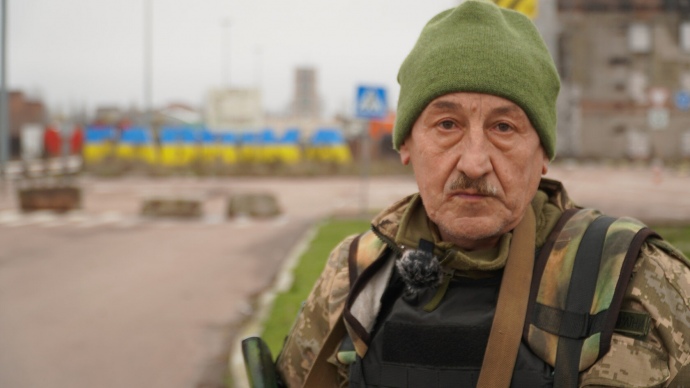 Mykola Zozulia, a territorial defence fighter.
Mykola Zozulia, a territorial defence fighter.
One of Kherson's defenders who stood firm to the endAll photos: Oleksii Bratushchak
The territorial defence rises to defend Kherson
Around 05:00 on 24 February, Dmytro Ishchenko, the commander of the 124th Kherson Territorial Defence Brigade [the position he held at the time of the events described in this article, March 2022 - ed.], received a phone call from the officer on duty. He was told that the full-scale invasion had begun. The leaders of the brigade and the Kherson Battalion gathered in the military unit in central Kherson.
"By the time I got to the military unit, there were already reports of fierce fighting in Chonhar," recalls a soldier with the alias Zmii (Snake). He was an instructor in a counter-sabotage company at the time. Read more: Serhii Deineko, Head of Ukraine's State Border Guard Service, on texting Zelenskyy at 05:17, telling a Russian warship to go f**k itself, and the Monaco Battalion
The brigade then comprised six battalions of 20-40 soldiers each. On the day of the invasion, they were ordered to recruit additional fighters, though there was still no general mobilisation order that morning. "The order was not signed until around 14:00.
Before that time, we could call and select people, but we couldn't officially recruit them," Ishchenko says.
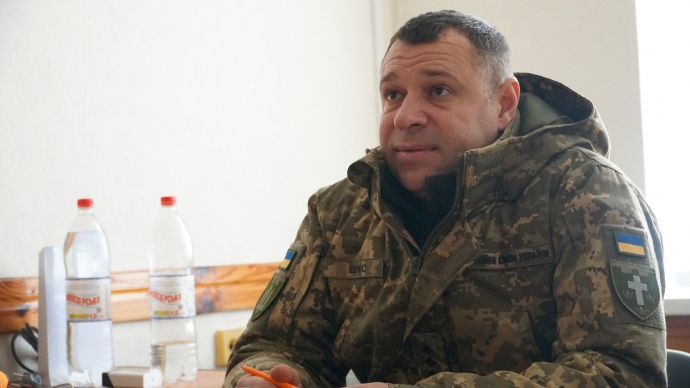 Dmytro Ishchenko, the commander of the 124th Kherson Territorial Defence Brigade in February and March 2022
Dmytro Ishchenko, the commander of the 124th Kherson Territorial Defence Brigade in February and March 2022
Meanwhile, volunteers had begun to gather outside the military enlistment office in the early morning. Mykola Zozulia was among them; he was there by 07:00. Zozulia recalls seeing up to a thousand people there: Kherson residents were demanding to take up arms, but the enlistment office was still closed.
"There was one soldier with a machine gun there - he kept shouting that he wouldn't let anyone in. We stood there a while, and about half of the guys who were there left," Zozulia says. Inside, officers of the Territorial Defence Forces were calling reservists and telling them they had to report for mobilisation.
Former Kherson Mayor Volodymyr Mykolaienko was there by the enlistment office building, among other Kherson residents. His presence meant a lot to many of the people who had gathered there. "Mykolaienko was over 60, so he was told to go home.
But he replied, 'Son, you've lost your mind! Give me a gun'," recalls Serhii "Hrybochok" (Mushroom) Serheiev, a fighter in the Territorial Defence Forces' Kherson Brigade. By the time Kherson's territorial defence received the order to proceed with mobilisation, its leadership had moved to the village of Naddniprianske, where the city's Territorial Defence Forces were stationed.
A new home for Kherson's Territorial Defence Forces: an abandoned school on the city's outskirts
The village of Naddniprianske is officially part of the city of Kherson.
In reality, however, it is located outside the ring road, some 8 km away from the Kherson Cotton Mill, where most municipal buses terminate. In January 2022, Kherson's Territorial Defence Forces were allocated the premises of a former school - which had stood abandoned for over 10 years - to set up their base. As of 24 February 2022, the building had no heating, electricity or running water, and some of the windows were missing.
Other Territorial Defence units had similar problems all through Kherson Oblast. "The battalions in Skadovsk and Kakhovka were allocated similar premises. Some battalions asked the local government to improve the conditions, which were unsuitable for housing units," recalls Oleksandr Fediunin, a brigade commander.
Some said that allocating premises like that to Kherson Oblast's Territorial Defence Forces was an act of sabotage. These allegations were aimed in particular against the local branches of two political parties: Opposition Platform - For Life (OPFL) and We Live Here, the party of Kherson Mayor Ihor Kolykhaiev.
 Maksym Bervinov, a Territorial Defence fighter, at the Naddnipriansk base, December 2022
Maksym Bervinov, a Territorial Defence fighter, at the Naddnipriansk base, December 2022
From around 14:00 on 24 February and until late that night, Territorial Defence Forces in Naddniprianske recruited nearly 500 volunteers. The main issue for the poorly equipped base was not the lack of electricity, heating or running water: it was having nowhere to store weapons.
All of the weapons for the battalion and the brigade were stored at another location, 7 km away from Naddniprianske, in warehouses located between the villages of Antonivka and Sadove.
Not enough weapons for everyone
On the afternoon of 24 February, Territorial Defence fighters were ordered to report to the warehouses to be issued weapons. Yevhen "Zmii" and Vitalii Chumak volunteered to pick up their brigade's weapons. Zmii says that they got to the warehouse quickly and had to wait until 14:00 for a civilian truck, which the weapons would be loaded into.
"We started loading up [the truck]. And just at that moment six Russian K-52 helicopters flew right over the military base. They gathered in a circle, then three of them started to take up combat positions and drop their heat shields.
We realised that a landing operation was imminent. And we weren't even armed yet," Zmii recalls. The Ukrainians were lucky, however: the Russians did not attack their warehouses that day.
All Territorial Defence battalions had to drive to the base to obtain their weapons. The Kherson Battalion was able to secure the largest amount of weapons, enough for all of the battalion's fighters. Once again, the Russians made an appearance just as the fighters were loading the weapons into their vehicles.
"Several K-52 helicopters approached; they fired a few rockets to scare us. Then a Mi-8 jet came over and attempted a landing operation. The guys guarding the warehouses fired on them," says Senior Lieutenant Oleksii Vorontsov.
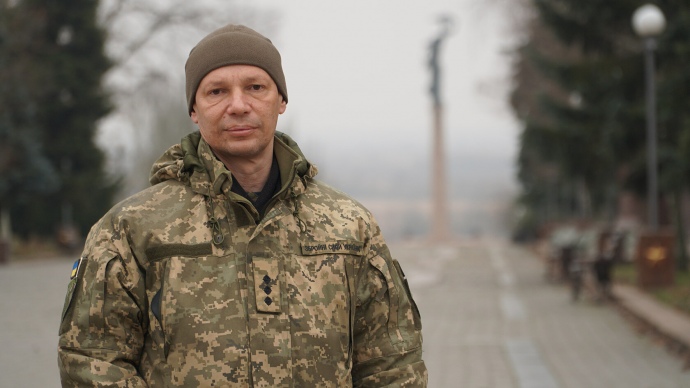 Oleksii Vorontsov was loading weapons into a vehicle to be taken to Territorial Defence battalions when the Russians attempted a landing operation
Oleksii Vorontsov was loading weapons into a vehicle to be taken to Territorial Defence battalions when the Russians attempted a landing operation
The Russians eventually carried out their landing operation to the south of the base.
Their likely goal was the bridge over the River Dnipro, not the ammunition warehouses.
The battles for the Antonivka Bridge
There have been several articles about the so-called "Hostomel landing party" in the Ukrainian media. Russian propaganda has presented the landing operation in Hostomel as a truly heroic feat. Meanwhile, both sides have largely ignored the Russian landing operation near the Antonivka Bridge in Kherson Oblast, even though this operation played a key role in the Russian occupation forces' ability to quickly capture Kherson Oblast.
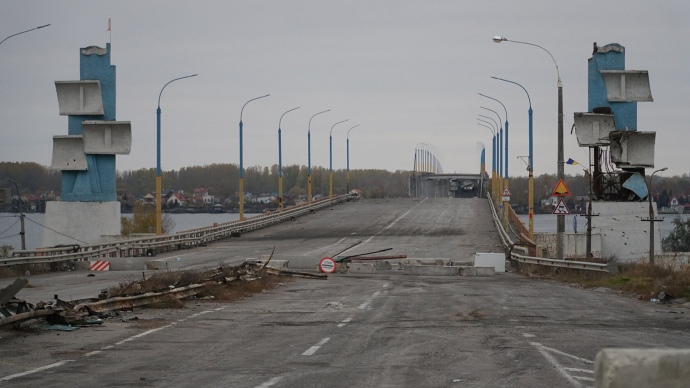 Many fierce battles were fought for the Antonivka Bridge, November 2022
Many fierce battles were fought for the Antonivka Bridge, November 2022
A Kherson Territorial Defence brigade commander said that Russian landing forces had taken up positions in the vicinity of the Antonivka Bridge, near the towns of Antonivka and Sadove, by 11:00.
Around the same time, columns of Russian forces that had earlier set out from Crimea reached Nova Kakhovka and the Kakhovka Hydroelectric Power Plant. The [Ukrainian] 59th Iakov Handziuk Motorised Infantry Brigade was encircled on the left bank of the River Dnipro. Kherson's Territorial Defence Forces were supposed to help the 59th Brigade escape the encirclement.
Oleksandr "Bereza" (Birch) Berezovskyi led the first Territorial Defence company. He recalls that around 15:00, the company halted at a former pig farm 2 km away from the bridge. They met the commander of the 59th Brigade and his deputy there.
The deputy turned out to be someone Bereza knew from when they served together during the Anti-Terrorist Operation (ATO) in Donbas; his alias was "Barda". Barda was the commander of Bereza's battalion. [The ATO is a term used from 2014 to 2018 to identify combat actions in parts of Donetsk and Luhansk oblasts against Russian military forces and pro-Russian separatists - ed.] "The brigade commander approached me and said, 1,200 of my people are stuck there, the [Russian] airborne troops are here.
We have to knock out the airborne troops and clear an opening for the brigade," Berezovskyi says. He counted the Territorial Defence fighters: there were 78 of them. He split them into two groups.
He led the first group, which had 54 fighters; the second group advanced in the same direction but on the other side of the road that led to the bridge. Both groups approached their destination as it was getting dark. "Then I saw a plane.
It struck once, then again and again. I was a bit disoriented. One of my guys shouted that he was wounded, then another.
Then I felt something damp: a projectile had landed right between me and another guy. Everyone got injuries to the lower part of their bodies, to their legs. Then I realised what it must have been like on 22 June 1941 [when Germany invaded the Soviet Union].
It was exactly the same. But I survived," Bereza recalls. Four soldiers in Bereza's group sustained injuries in the Russian airstrike, including Berezovskyi himself.
He lost consciousness and was loaded onto an amphibious armoured scout vehicle, which evacuated him to Chornobaivka and then Mykolaiv. One of the wounded fighters - an officer from the Territorial Defence Forces' Nova Kakhovka Battalion - died there. Another company, this one under Mykahilo "Lyman" Baliuk's command, set out from Naddniprianske towards the Antonivka Bridge 40 minutes after the first one.
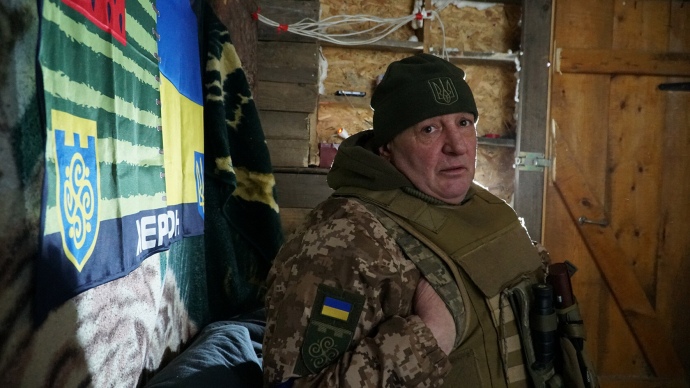 Mykhailo "Lyman" Baliuk, a company commander, took part in the battle for Antonivka Bridge
Mykhailo "Lyman" Baliuk, a company commander, took part in the battle for Antonivka Bridge
"I'd barely managed to staff the company and get weapons for about 52 people - an assault rifle and four magazines each - and then we were on the bus," Lyman says.
His company also came under attack from two Russian planes. "For the first time ever, I wanted to scream. I remember lying in a bog, I checked myself - I didn't seem to be injured, but I couldn't breathe.
I heard screaming all around me, it was dark. I started screaming! Everyone gathered around me and dug me out of the earth - I was covered all over," Baliuk says.
By that point, a third company from Kherson Territorial Defence Forces had set out from Naddniprianske. Members of the territorial defence held their ground near the Antonivka Bridge until at least 20:00, though some soldiers say they remained there until midnight. Eventually they were ordered to retreat, but only after the last vehicle in the column of the 59th Brigade equipment had left the Russian encirclement, followed by a number of civilian cars.
Several soldiers from the 59th Brigade were awarded the title Hero of Ukraine for their role in the Antonivka Bridge battle and for leading Ukrainian forces out of the Russian encirclement. The defen?e of the Darivka Bridge After returning to the school in Naddniprianske, the soldiers had the opportunity to take a break.
At about 04:00 (Kyiv time) on 25 February, a group of Territorial Defence Forces was sent on two buses to the Darivka Bridge to prevent troops from landing. This is a crossing over the Inhulets river from Nova Kakhovka to Kherson. At one point, a Russian column appeared from the direction of Nova Kakhovka.
"They saw us and didn't go to the bridge. Perhaps the Russians thought that the bridge was mined. And they stopped," says Baliuk.
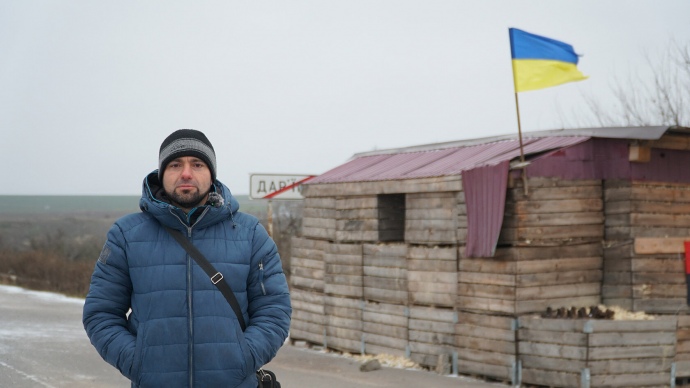 Oleh "Medvid" (Bear) defended the Darivka Bridge, December 2022
Oleh "Medvid" (Bear) defended the Darivka Bridge, December 2022
However, the Territorial Defence Forces soon received reports that the Russians had crossed the Antonivka Bridge.
To avoid being surrounded without much means of resistance, Ihor Likhnov, the commander of the Kherson Battalion, who was also on the Darivka Bridge, decided to retreat.
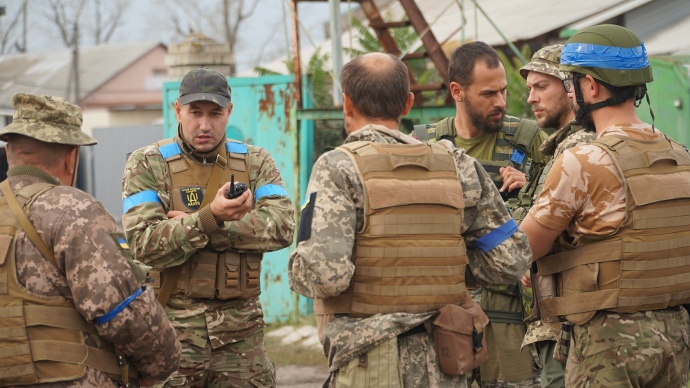 Ihor Likhnov, Commander of the Kherson Battalion (with walkie-talkie), September 2022
Ihor Likhnov, Commander of the Kherson Battalion (with walkie-talkie), September 2022
How the Territorial Defence Forces were the last men standing in Kherson On 23 February, a meeting was held in Kherson on introducing a state of emergency in Ukraine. Hennadii Lahuta, head of the oblast administration, invited city and regional leaders and security forces.
Brigade Commander Dmytro Ishchenko was also present. After the meeting, at a briefing for journalists, Lahuta announced that an operational headquarters was being set up in Kherson Oblast under his leadership. "I'm asking everyone to stay calm.
We are working to make you, residents of Kherson Oblast, feel safe. We will stand with our people to show that we are a united team that is working for the benefit of the state," Lahuta assured everyone. Brigade Commander Ishchenko describes what happened at the non-public part of the Oblast State Administration meeting.
"The head of the ATC [anti-terrorist centre - ed.] and the chief of the Security Service of Ukraine said there would be no invasion. This was at 19:00 (Kyiv time)," Ishchenko says.
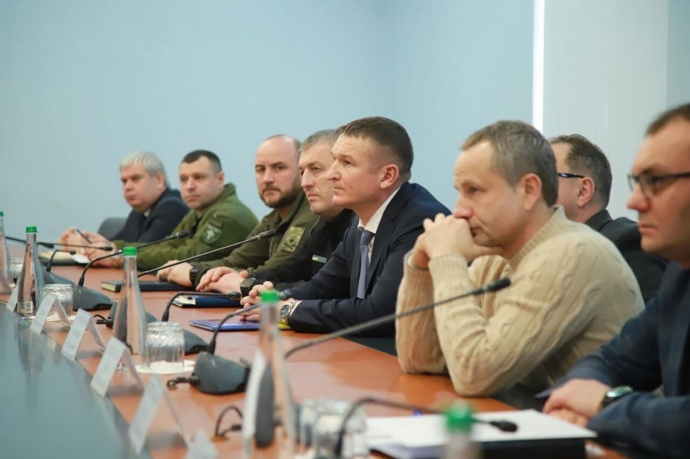 The meeting at the Kherson Oblast State Administration, 23 February 2022
The meeting at the Kherson Oblast State Administration, 23 February 2022
On the same day, a meeting also took place at City Hall. The mayor, Ihor Kolykhaiev, urged the people of Kherson not to panic.
23 February was not yet over, and the evacuation from Kherson had begun. Employees of the Se?urity Service of Ukraine (SSU) were the first to leave. "There were buses at the railway station for the families of SSU employees, and they were evacuated by 24:00 (Kyiv time).
Staff and families were taken out," says an employee of the Kherson police who asked to remain anonymous. On 24 February, the police also received an order to leave Kherson for Mykolaiv. But a few hours later, another order was received - to go back.
And then another one - to evacuate. "It turned out that some police officers were evacuated to Mykolaiv and Voznesensk. By 1 March, more than a hundred police officers remained in the city - the ones who decided to stay in Kherson for personal reasons.
In total, the Kherson Police has about 2,000 personnel," says an employee of the Kherson police. "The police and the SSU left the city on day one. People did wonder why.
I still don't have an answer," sums up Dmytro Ishchenko, the commander of the Kherson Brigade of the Territorial Defence Forces. National Guard units and border guards also left the city. President Zelenskyy had ordered local authorities to form Defence Councils and provide assistance to the military.
The local authorities in Kherson should have done this. Hennadii Lahuta, head of the Oblast State Administration, left Kherson on 24 February. "There was not a single headquarters to organise defence.
Not one. They ran away," is how Maksym Nehrov, a well-known veteran of the Anti-Terrorist Operation, briefly describes the actions of the Kherson authorities in late February. In March, during the occupation, Nehrov was abducted by the Russians.
After the liberation of the city, he raised the Ukrainian flag over Kherson City Hall. As of 28 February, the authorities had not set up any obstacles to hinder the Russians from entering the city. The only iron hedgehogs (anti-tank devices made of barbed wire entangled with stakes or iron bars) were placed on the main square in such a way that they did not even impede the traffic along the central avenue.
"From 24 February onwards, Mayor Kolykhaiev distanced himself from all the necessary procedures," recalls Roman Holovnia, Kherson's deputy mayor. On 1 March, as the occupiers were entering the city, Holovnia addressed the defenders of the city during a live broadcast from Kherson City Hall that was featured in the 24/7 national newscast:"K!ll all of those f**kers so there isn't a single one of them here." The next day, with Kherson now occupied, Kolykhaiev wrote on Facebook: "All that's going on in our city right now is politics, which I hate."
He stayed in Kherson for a few more months and continued to work to keep the occupied city going until he disappeared. Kolykhaiev's son says his father is "in Russian captivity", yet the local authorities have been reluctant to comment on the mayor's fate. So on the very first day of Russia's full-scale invasion of Ukraine, the city of Kherson was defended solely by the territorial defence forces.
"When everyone was evacuating in convoys from Kherson on 24 February, heading for Mykolaiv, I decided to stay," reveals battalion commander Ihor Likhnov. "I really didn't want to leave Kherson. I had one mission: to stay in Kherson and defend the city to the end." Oleg Kulinich, head of the SSU in Crimea, and Ihor Sadokhin, head of the SSU's anti-terrorist centre in Kherson Oblast, were later served with notices of suspicion of treason by the investigative authorities.
Investigators believe that both provided the Russians with military information on the location of minefields and the location and number of units of the Armed Forces of Ukraine that facilitated the occupiers' rapid advance in Kherson Oblast. The defenders of Kherson return On the evening of 25 February, after the Territorial Defence Forces had withdrawn from the settlements of Naddniprianske and Molodizhne to Kherson, Brigade Commander Ishchenko gathered the territorial defence command at the Kherson Oblast assembly point on Parovozna Street.
"On the morning of 26 February, the command met together in the recruitment office, and new people started arriving to collect their weapons and then be sent off to form battalions," recalls Oleksandr Fediunin, a member of the brigade command.
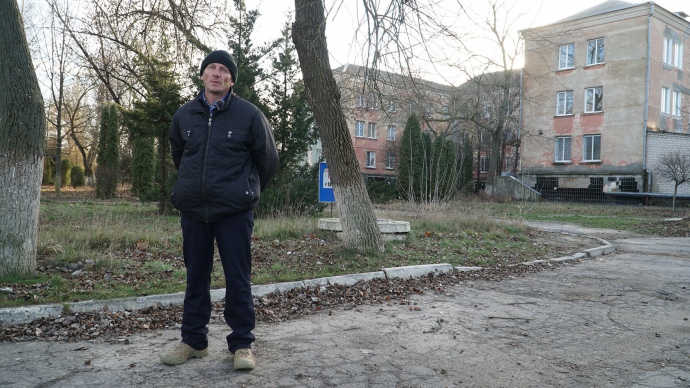 Mykola Mysiuk, a defender of Kherson, at the territorial defence base in a boarding school building, December 2022
Mykola Mysiuk, a defender of Kherson, at the territorial defence base in a boarding school building, December 2022
"There weren't enough weapons for everyone. People arrived armed with guns and knives. One time this old man brought a few zinc cartridges and a machine gun.
I asked him, 'Where did you get those from?' He replied, 'I've had them since the Second World War. Here you go - give 'em a good kicking'," Likhnov recalls. On 28 February Dmytro Kuzmenko, commander of the Bilozerka Battalion, said anyone who was not ready for combat action should hand their weapons over to those who needed them and leave.
Despite this warning, no one was willing to leave the territorial defence. In fact, many members from various units were indignant that they were sitting around while there was fighting going on around them. The Kherson residents expressed their willingness to fight to the brigade commander during formation.
Many remembered his response. "What can your machine gun do against a tank? You'll barely scratch its surface."
"All the personnel were ready to tear me to shreds because I didn't let them go and burn the enemy.
90% of them were ready to fight," recalls the commander. The territorial defence is raring to go On 28 February, the Russians completely surrounded the city.
Zmii (Snake) from the counter-sabotage company spent a few days wandering around the outskirts and monitoring the Russians' movements. He says Russian reconnaissance groups started gradually entering Kherson in the afternoon. Brigade Commander Ishchenko adds that it was mobile monitoring groups who supplied him with information about the Russians' movements.
After that he divided the Kherson and Bilozerka Battalions into five groups to monitor the five entrances to the city. "I was hoping the Russians wouldn't enter the city in armoured vehicles. But they did," Ishchenko recalls.
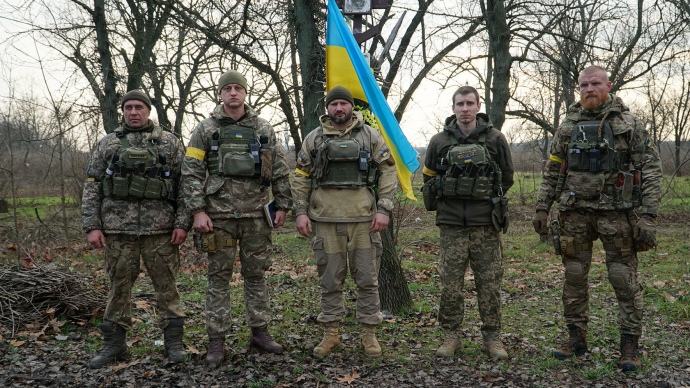 Members of the 194th Bilozerka Territorial Defence Battalion who defended Kherson on 1 March
Members of the 194th Bilozerka Territorial Defence Battalion who defended Kherson on 1 March
Dmytro Kuzmenko, Commander of the Bilozerka Battalion, reports that at 07:30 on 1 March, he was tasked by the brigade commander to move to two locations in order to block the entrances into Kherson.
The first company, together with Serhii Bodnar, head of the staff, headed to the area around a lyceum [a specialist secondary school - ed.] in Bilozerska Square. The second company, led by the battalion commander, went to the Buzkovyi Park area. There were about 40 people in each company.
The soldiers brought machine guns, three crates of Molotov cocktails, grenades, and four "flies" [portable anti-tank grenade launchers - ed.]. Likhnov led one group to the Saliut shopping mall. He sent the group headed by company commander Lyman to the Fabryka shopping mall, and the group headed by commander Yasynskyi to the entrance from Chornobaivka.
All these territorial defence groups, besides the one deployed near the Saliut shopping mall, fought against the Russians. The battle outside the lyceum On the evening of 28 February, Oleh, a Kherson local, saw a call go out on social media urging people to gather at the entrance to the city on the Bilozerka side to prevent the occupiers from entering the city.
Oleh called a friend of his, and the two of them went to the place specified. There were already 30-40 people there, of which only two police officers had assault rifles. The fighter known as Vedmid (Bear) had only a knife with him.
"Why did I come with only a knife? I felt that I had to go. I also had a lighter - I wanted to burn the Russians with Molotov cocktails," Vedmid says.
Local residents felled trees to block the passage of the Russian Tigers [light armoured vehicles - ed.]. In this way, the vehicles could be blocked in and then incendiary mixtures could be thrown at them. By one o'clock in the morning, everyone was freezing.
The police told the boys to leave. And by about 10 o'clock in the morning, a company of the Territorial Defence Forces' Bilozerka Battalion had advanced to this area. One group of Territorial Defence soldiers entered the grounds of the lyceum, the other went to the roundabout on Bilozerska Square.
Kostiantyn Kozak was in the second group. On the approach to the roundabout, Kozak spotted a man. It was his former commander, Viktor Yevdokimov.
He informed the Territorial Defence officer that the Russians -- about 40 troops and a Tiger -- were already heading in the direction of the roundabout. Kozak and his brothers-in-arms took up a position behind the concrete block of an advertising billboard. When they saw the Russians, they opened fire from machine guns.
Two Russian soldiers were killed; one was wounded and began to scream loudly. The Russians started throwing smoke grenades so they could get him out.
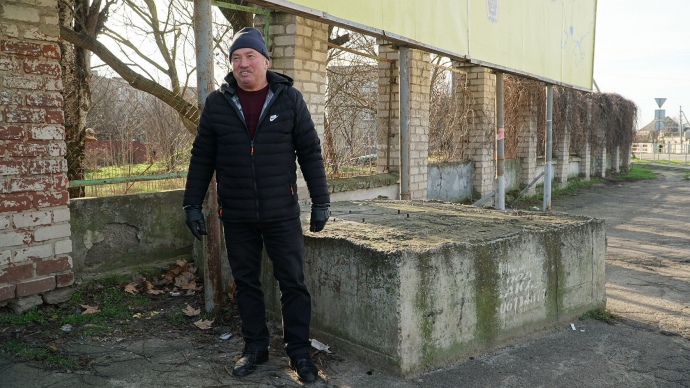 Kostiantyn Kozak at the place where he fought on 1 March 2022
Kostiantyn Kozak at the place where he fought on 1 March 2022
Junior Sergeant Serhii Voloshchenko was among the fighters in the first group who entered the lyceum grounds. He says the Territorial Defence came under sniper fire there.
In total, according to the Kherson police, seven Territorial Defence fighters died in the battle near the lyceum. The battle of Buzkovyi Park The Bilozerka Battalion company headed by Battalion Commander Ishchenko had arrived in the area of Buzkovyi Park.
When they got there, the unit split into two groups on different sides of Naftovykiv Street. One group went into Buzkovyi Park, while the other took up positions near to the stone fence behind the park. The Russians discovered the Territorial Defence soldiers immediately.
Most likely, Russian snipers had taken up positions on the roof of the Epitsentr shopping centre in advance and watched the Ukrainians' movements.
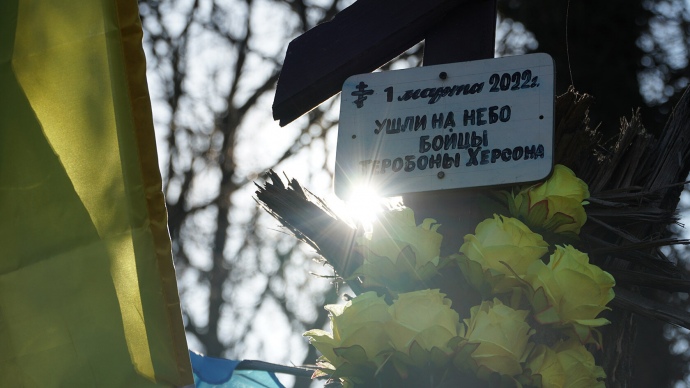 Buzkovyi Park, December 2022. The sign reads: "On 1 March 2022, fighters from Kherson's Territorial Defence went up to heaven"
Buzkovyi Park, December 2022. The sign reads: "On 1 March 2022, fighters from Kherson's Territorial Defence went up to heaven"
At the beginning of the battle, snipers killed several Territorial Defence soldiers. Later, they opened fire on the Ukrainians from a large-calibre machine gun, and one infantry fighting vehicle (IFV) drove right into the park, where the soldiers were hiding behind the trees.
On the other side of the road, Oleksandr Kozak had a good view of all this. "I could see our boys being torn apart," Oleksandr says. "I started to feel panicky. I thought something had to be done, because the IFV was continuing to shoot at them."
He had two RPG-22s [one-shot disposable anti-tank rocket launchers - ed.]. He moved forward a little, to the rear of the IFV. The rear compartment of the armoured vehicle was directly in front of him.
Kozak then fired a shot from an RPG. The IFV was out of action for some time. The Russians immediately opened fire in his direction.
The following day, the people of Kherson saw the aftermath of the battle in Buzkovyi Park. Several local residents went into the park on 2 March. One of them filmed everything he saw on video.
The footage shows the men's bodies; they had been torn apart. In total, according to the Kherson police, 12 soldiers of the Territorial Defence were killed in Buzkovyi Park. The Russians lost 10 people (killed or wounded).
The battle at the Fabryka shopping centre Members of Kherson's Territorial Defence had arrived at the Fabryka shopping centre a few hours before the Russian convoy entered the city. This gave them some time to prepare.
An employee from the nearby Epitsentr home improvement store helped. He supplied concrete blocks to block the road. They also managed to dig small trenches.
The entire unit had only one grenade launcher. But this was enough to delay the Russians and make them hesitate for a long time about whether to advance on the city's defenders. "Until about midday, the Russians were afraid to advance into the city.
They thought the Territorial Defence would really lay into them," says Mykola Zozulia, a member of the Territorial Defence. At first, the Russian army came in armoured personnel carriers transporting infantry. The city defenders opened fire, and several Russians fell.
Half an hour later, two or three Russian tanks appeared. They started pounding at the Kherson defenders, but mostly overshot the mark. Then enemy mortars joined in.
During this battle, the Russians struck the Fabryka shopping centre, and the building was engulfed in flames. Almost the entire shopping centre burned down. At some point, the Kherson defenders realised that the Russian infantry had bypassed them on a parallel road from the direction of the railway and had begun to enter the defenders' rear from the Epitsentr store.
By that time, the Territorial Defence members had almost run out of ammunition, so they decided to retreat. Zozulia sums it up: "They didn't just walk in here shouting 'Hurray!' and 'Long live Putin!'" They got their teeth kicked in here."
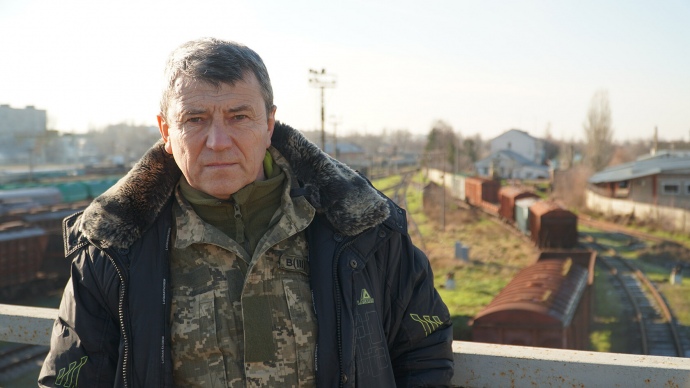 Soldier Ihor Kuraian at a battlefield on Mykolaiv Highway on 1 March 2022
Soldier Ihor Kuraian at a battlefield on Mykolaiv Highway on 1 March 2022
Kherson's modern-day "Heroes of Kruty" The last defenders of Kherson from the local Territorial Defence held out until 1 March.
This gave the defenders of Mykolaiv [the next big city and oblast capital after Kherson along the Russian advance route - ed.] a six-day head start to prepare their defence. Time that Kherson was never given. "I was very pleased to hear [Vitalii] Kim [Head of the Mykolaiv Oblast Military Administration - ed.] thanking the people of Kherson for delaying the enemy, so that the people of Mykolaiv were able to dig in a little and build at least some defence," says Mykhailo "Lyman" Baliuk, a company commander with the Kherson Battalion. "So our fight was not in vain.
We weren't just fighting for Kherson. We were trying to keep out the enemy for the whole of Ukraine." ****
The history of Kherson's defence has its traitors. But there are many more heroes in this story who immediately rushed into battle to stop the invaders. And these defenders fought to the end, many of them to their last breath.
Their heroic deeds are the most important argument against anyone suggesting that Kherson surrendered without a fight. True, they were unable to stop the occupation of the city, and they suffered significant losses, but they did not surrender. So they are the ones who will go down in the history of Ukrainian resistance, not the traitors.
And in this history, the defenders of Kherson will take their place next to the Heroes of Kruty. For reference: After the Bolsheviks had taken over Russia, their forces advanced towards Kyiv to assert their control over Ukraine. Present-day eastern and central Ukraine had been under the rule of the Russian Empire before the Revolution, but Ukraine did not want to be part of the new Bolshevik Russia and was resisting the Bolsheviks.
Following the Revolution, Ukraine formed its own government and a short-lived independent state. The resistance failed, and Ukraine was incorporated into what became the USSR. Among the numerous battles of that war, one which deserves special attention is the battle fought on 29 January 1918 near the town of Kruty (about 130 km east of Kyiv) by a battalion composed of Ukrainian students.
Greatly outnumbered by the Bolsheviks, and fighting against a more experienced and better equipped enemy force, this Student Battalion was completely wiped out. Most of the students died in the battle, while those taken prisoner were cruelly tortured and shot the next day. The battalion did its duty honourably.
It delayed the enemy for several days, thus enabling the Ukrainian government to carry out an organised withdrawal from Kyiv. Oleksii Bratushchak, Kostiantyn Rieutskyi Translated by Olya Loza, Yuliia Kravchenko, Polina Kyrylova, Theodore Holmes and Oxana Hart
Edited by Teresa Pearce